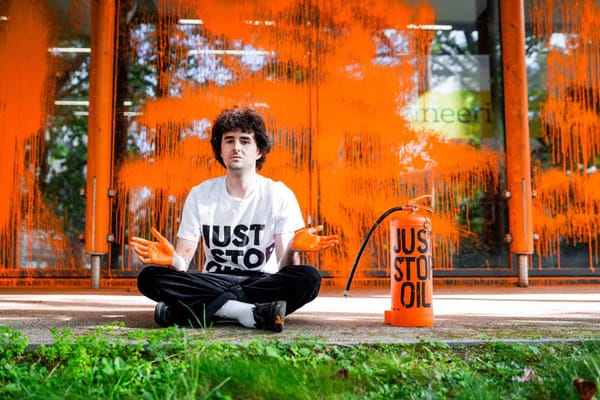The Geish Manifesto, or how to wear your rubbish
In London, a groups of creatives and squatters are creating clothes straight from the local bins – I asked them why and caught a glimpse of the weird world of geish.
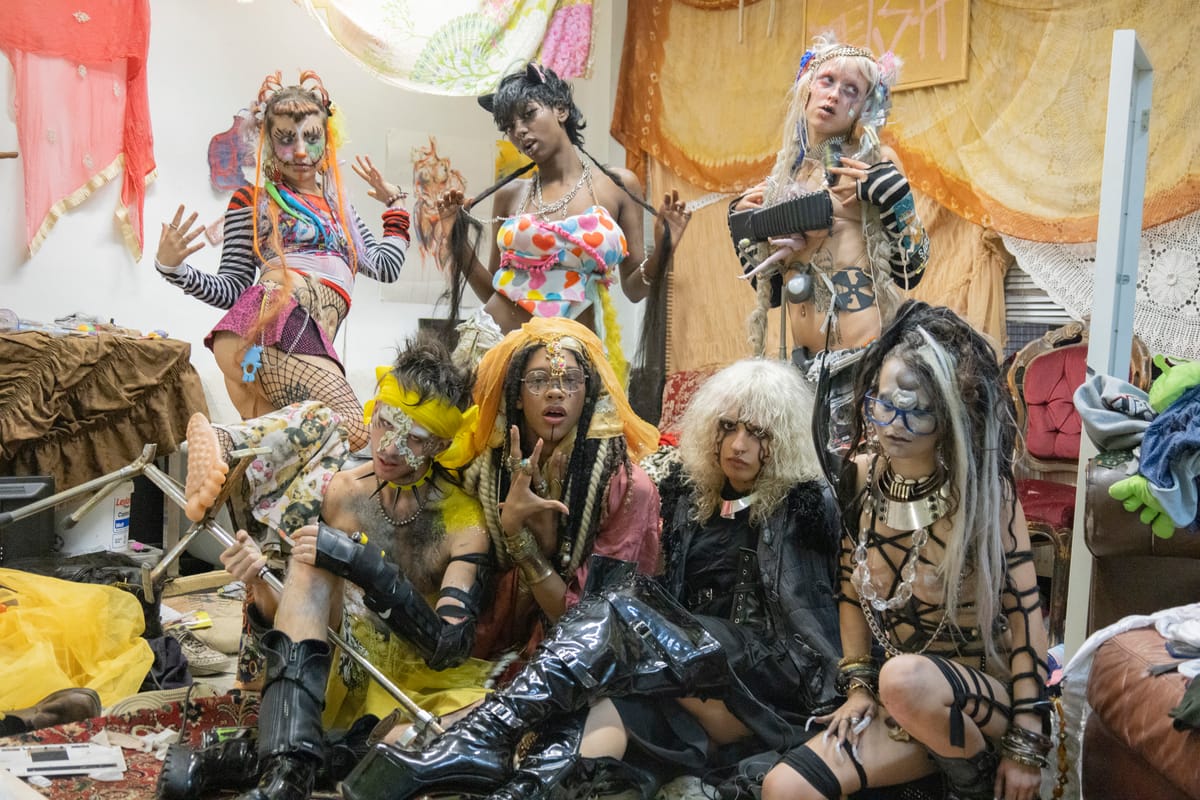
In June last year I visited a friend’s squat in East London. The former office block and gym had been converted into a home where they opened a freeshop on the ground floor, handing out free hot drinks, food and clothes to anyone that came past. Whilst there, I saw some of the people that lived upstairs carting scraps of fabric, pieces of metal and random objects in and out on shopping trollies. I asked what it was all for and a drag queen, Princess Pathogen, handed me a copy of The Geish Manifesto. The short zine explained the ripped clothes, bits of scaffolding and rubbish were getting chopped up and pinned together to create striking outfits.
Geish (pronounced geesh) was used by drag performers to describe being in a full look in the queer black and Latinx ballroom culture in America during the seventies and eighties. Tired of facing racism in ballrooms, queers of colour began forming their own events. Drag performers competed in categories for prizes and created their own costumes. 'Houses' sprang up where queer people could live together in community, refine drag and push its limits. Over time drag morphed into the hugely popular polished version we see now on Ru Paul’s Drag Race and elsewhere - a version of drag practitioners of geish would critique for its inaccessibility.
DIY has often been an important part of drag with performers creating their own outfits like Johanna Constantine’s ‘Toast Dress’ – a black dress adorned with toast and pretzels and an emerging subculture in London is now giving geish a new meaning. They take their inspiration from the DIY attitude in drag and also the punk scene, but critique punk today as an aesthetic that has been absorbed and commercialised by fashion houses like Vivienne Westwood. Geish is the process of creating DIY clothes from the dregs of consumer culture. It resists any firm definition to try and stop its co-option by the mainstream. It's anti-fashion that wants to stay anti-fashion and let people “look cunt without the coin”.
Shane (Princess Pathogen) was introduced to geish as a drag queen but it's become part of his everyday style now, merging the drag and not drag into one look. “I know a lot of drag queens who really give as drag queens but when they’re out of drag are like 'no I can’t do anything’. I like merging the drag and not drag and having it all exist on a spectrum” says Shane. “I look at those other queens and wonder why those people aren’t doing it like this because this just has so much more queer expression. It's like come on you can literally make anything out of anything. You don't need to be paying these designers loads of money for clothes and stuff” he explains.
“With drag, there's a very big culture of you have to do this this way. You use this type of padding and use this for your eyebrows. I see so many people getting into it purely to go on Drag Race and mirror the same standards it sets. I love making outfits that are grander than all of those things and cost so much less” Shane adds.
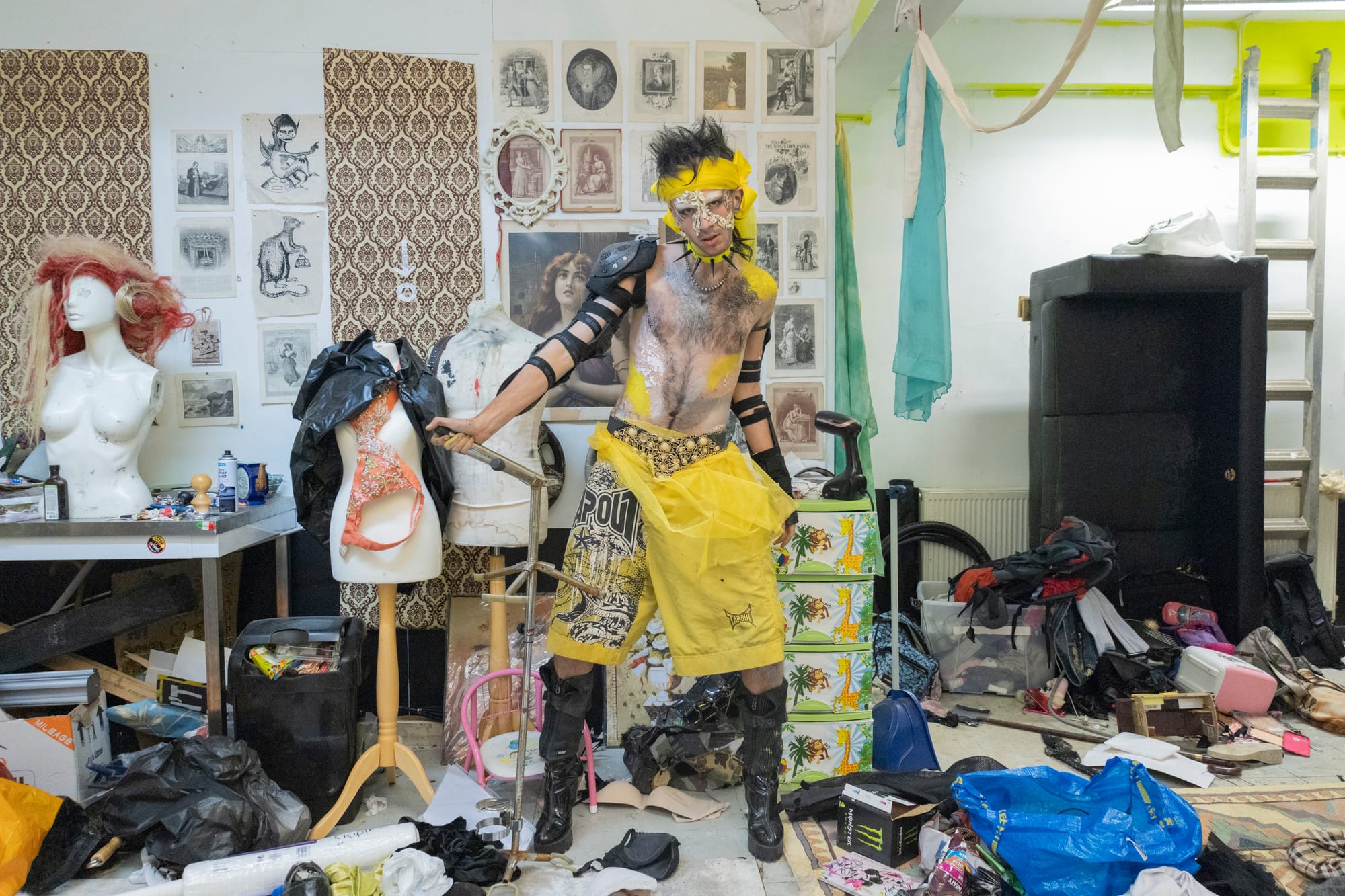
I revisited the squat to understand geish. Shane greeted me at the door, cracked grey paint peeling from his torso – the remnants of his costume from a performance the night before – with Lilyth, another squatter. “I fell asleep at nine this morning” Shane admitted, before wondering out loud how he would incorporate the body paint into his outfit later.
Despite effectively writing the book on it, Shane is apprehensive to define geish and set boundaries around what it is. Even the use of the word itself is contested; is geish something you do, a noun, an adjective, or all three? “We talk about “the scene” but it's always ironic, it feels weird saying these people are this and these people aren’t. It's too blurry” he says, “geish is a word that has pre-existing meanings and future existing meanings. I don't really want to define it, I just want to put a stamp on it.” Because there isn’t a firm definition, it can be difficult to work out how widespread geish is but Shane does say copies of his manifesto have travelled as far as Canada and Australia. A copy was even spotted in a video on FKA Twigs' Instagram story with the music artist proclaiming it "the most important thing ever!"
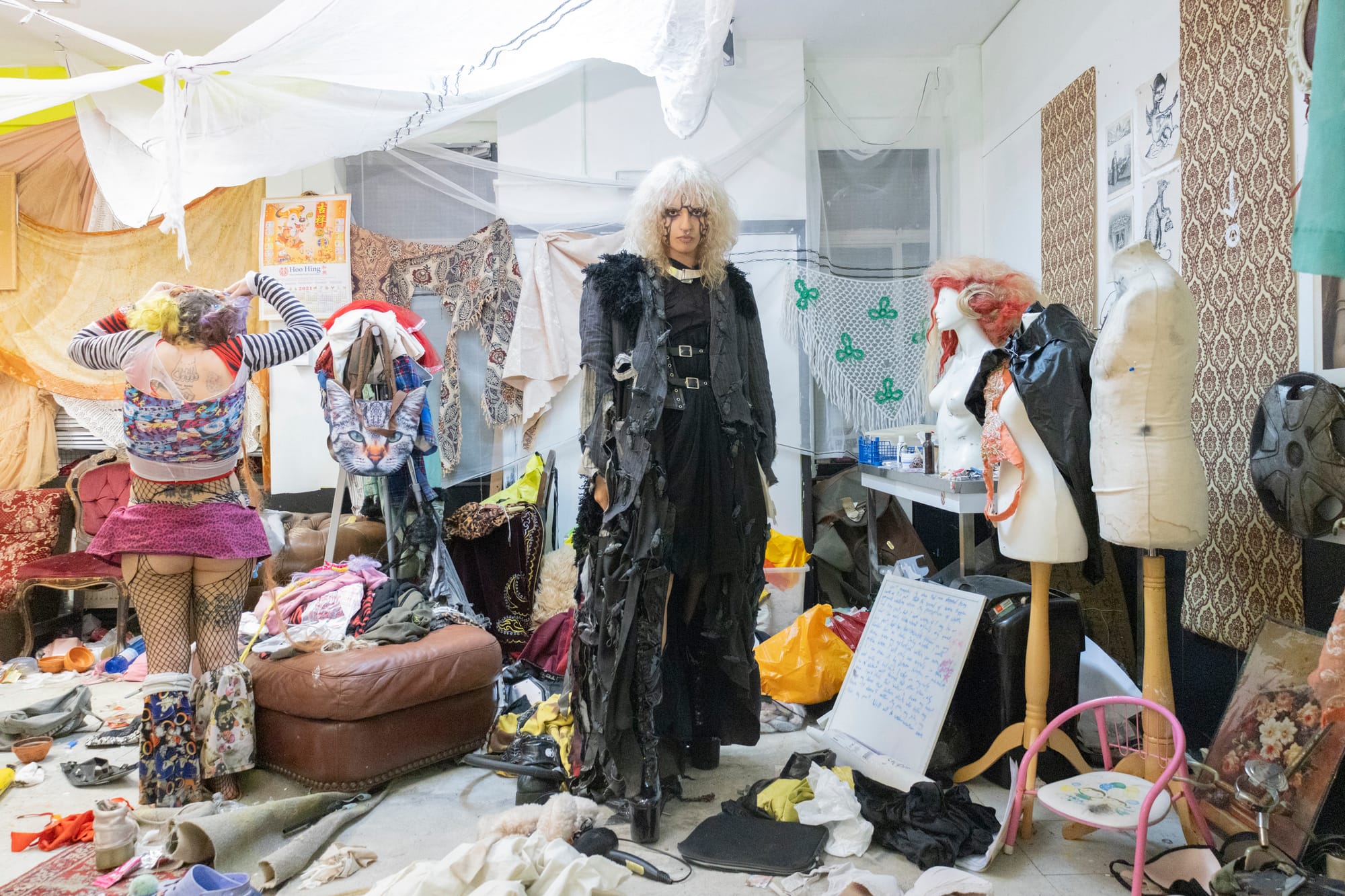
We entered the room where the freeshop used to be. It looked like an explosion at a haberdashery; scraps of cloth, bits of lace, string and clothes were strewn about the room. All could potentially end up in an outfit. The plan was to take me to find materials in nearby bins and then watch them be turned into clothes, but there was plenty on the floor here for the seven young creatives that agreed to show me geish.
One person there was Hazel, who works in performance and events organising. When I first met Hazel, she was covered head to toe in red paint and little else for a music video. This time, as she entered Hazel announced her disappointment that she hadn’t collected any pieces for her outfit on the way. “I just wanted to find bits of bikes or something” she explained with an innertube slung across her shoulder before grabbing bandages and rubbing them in black paint to wrap around herself later.
What defines geish, is the process of making it. Geish must be freely obtained, often from bins, leftovers from car boot sales, the streets or bought second hand and then pulled together with safety pins, string or tape. Hazel says she’s been creating clothes this way since she was little, geish is simply a new word to describe it. “I've always been doing creative stuff, I’ve always been making things since I was a kid” she says, “I think what it really comes from is knowing that I have a way that I want to present myself, but not having the money to buy cool clothes.”
“All the clothes I would have were my dad's clothes and stuff like that. Because I'm small, I would end up cutting them up. Everyday I’d be really late to school from cutting up my clothes and glueing them. It's the creativity that comes from having nothing.”
Rummaging through bins isn’t everyone’s idea of fun but Hazel disagrees. “Every day is Christmas” she says, explaining a sentiment shared by many regular bin divers with a Calvin and Hobbes comic strip: “They're going through the dirt and they're like, ‘what have you found?’ And Calvin answers, ‘oh, a mouldy toothbrush, an old stone, socks, a broken book. It's great, there’s treasure everywhere!’” Even still, they’ve found valuable items in bins, including a Nintendo 3DS and 4oz of cannabis and for the less glamorous items, Shane says there’s still a tale to tell about how they fell into his hands.
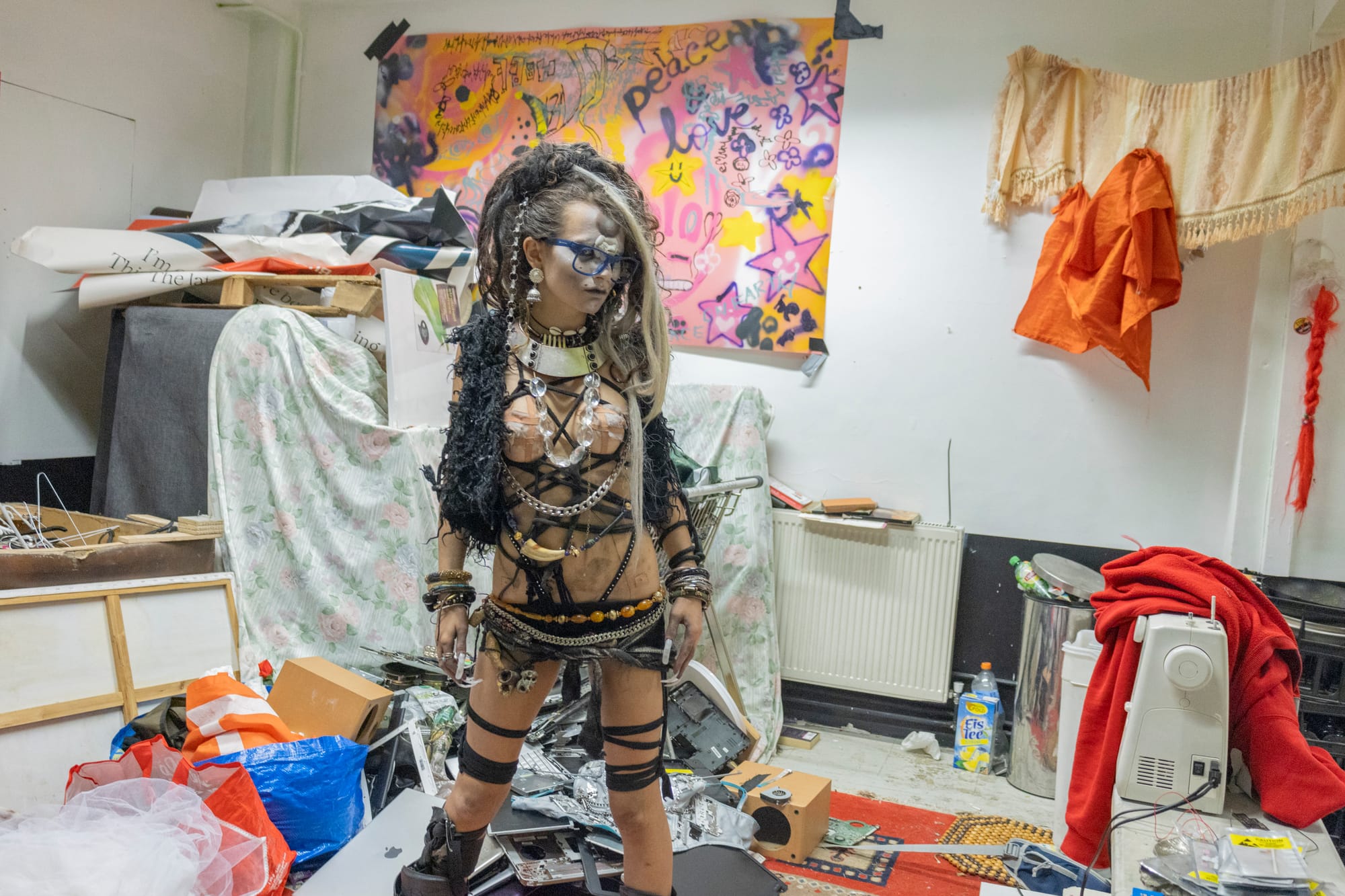
Geish must also be maximalist, constantly pushing its boundaries. It isn't trapped inside its own aesthetic in the same way as punk was, allowing it to be commodified. “When we say we want to make something more geish, we mean more decorated or just better. More excessive because the excessiveness and maximalism makes it” says Shane. When people are willing to wear McColl's crisp packets and pieces of bike, it's easy to assume they’ll wear anything but some are more discerning than others and distinct individual styles have emerged. “Some of us are quite picky,” says Zoot, a non-binary artist and event organiser. “Lilyth will tape a packet of crisps to herself but Hazel’s quite curated. Geish is so open to interpretation. I always say if it stays on its geish.” “But if it falls away, that's also geish,” adds Hazel with a giggle.
Hazel's style has mainly been pushed by her search for pushing the extremes of what her clothing can be, “I never was inspired by anything. It's just as soon as I've gone to one extreme it's not enough anymore. It's literally like an addiction I can't lie. I'll learn about painting my teeth with nail polish and then I'll be like, oh my god, that's not enough anymore. Next, I'll be super glueing stuff to my nipples.”
Taking geish off is almost as difficult as putting it on. “It's so relieving” Shane laughs as he stood in the room pinning sections of a football together to create a sort of armour, which would eventually be dropped in favour of some shin pads on his arms, “it's my favourite bit”. Hazel admits making clothes this way may not be the most functional:
“When I'm walking down the street and getting stabbed by fifty safety pins and my trousers fall to my ankles, I do sometimes think about practicality.”
Sharing clothes is also an important part of the culture around geish. Evra, a performance artist, and y’Sohnt, also a performance artist and classical pianist, came with items that had been gifted to them. Evra wore knee-high boots with a black dress a friend had stitched together for her. Growing up as queer and mixed race, y’Sohnt wasn’t allowed to be queer at home so creating and sharing clothes with other queer people of colour became a way of life. y’Sohnt also enjoys incorporating aspects of their Guyanese culture into their outfits. This one consisted of a sari Shane found and other sheets of fabric safety-pinned together in layers complete with a tignon, a type of headdress free black women in Louisiana were forced to wear by law in the 1700s that were often elaborately decorated.
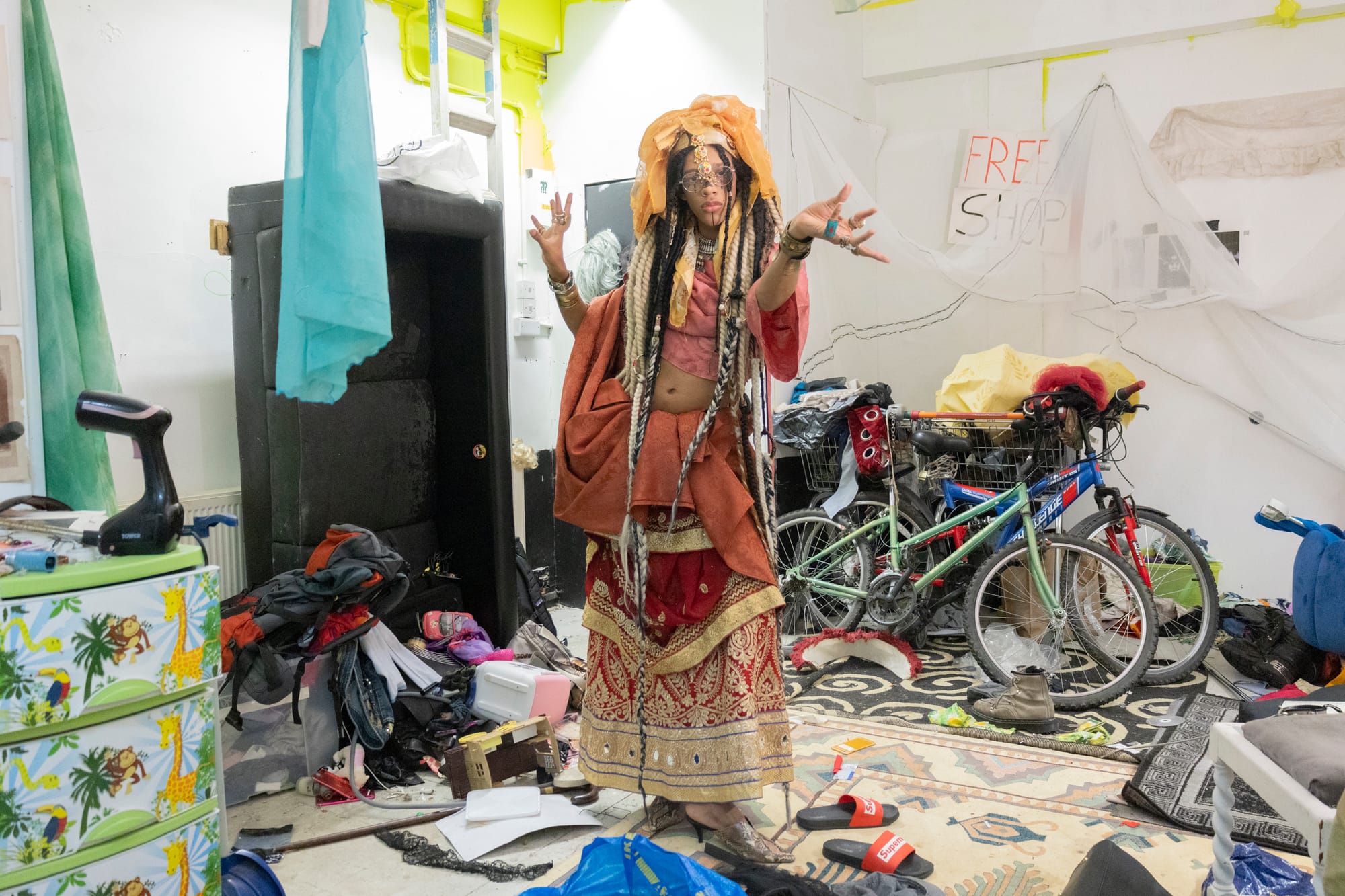
Part of the fun of geish is deliberately messing with people’s perceptions of you. Geish wearers recognise what we wear tells a story about ourselves to onlookers. Part of creating the clothes is deliberately choosing what story your outfit will tell, or which parts of yourself will be reflected or hidden in it. Geish is often described as armour worn to take on the world. In the manifesto Evra explains, “if how I’m perceived is out of my control, then geish is the tool I use to take it back… I get to explore the limits of my multiplicity and curiosity in the face of shame and ridicule.”
The result is outfits that look almost alien, but at the same time familiar. When you look closely you see that they are not in fact wearing costumes from the set of Dr Who but familiar, everyday items cobbled together into something cohesive that somehow works. The possibilities are endless. “We can make anything out of anything” says Zoot, “but I’m always like I've got nothing to wear!”
Whatever you might think of geish, whatever the outfits provoke, these guys insist it's not fashion. “We don't think instinctively, there's not inspirations, just each other” says Zoot. “I’ve never known anything about fashion. It's anti fashion” agreed Hazel, sticking some sort of playdoh on her head – “I like the shape, it makes me look like a neanderthal.”
Some of the pieces Shane makes he calls ‘post-cunt’. In queer slang, ‘serving cunt’ means to be chic or camp. For Shane then, post-cunt is deliberately wearing tacky or cringey clothing ironically. To demonstrate he holds up a t-shirt with an offcut from another top attached with safety pins. The offcut has tacky, shiny gold writing that reads “peace begins with a smile”.
Being post-cunt is recognising the story clothes can tell and subverting that story, flipping it on its head by changing who is wearing the outfit – imagine a teenage girl dressed in her grandad’s clothes. “Everything I do is layered and layered and layered in irony, the way I dress is a massive irony snowball” says Zoot.
Reactions to them in public can range across the good, the bad and the ugly; from curious but complimentary grannies to strangers playing clown music as they eat outside McDonalds and teenagers chucking rocks and urine at them. Which begs the question, why do this in the first place? Hazel thinks “there’s probably a couple screws missing, some cogs that have been taken out.” But they all get a deep sense of enjoyment and satisfaction from geish. “Why do I do geish? It's like asking Why do I breathe air?” says Evra. Hazel likens geish to a scene in Donnie Darko where the main character asks the figment of his imagination, Frank, why he’s always wearing a bunny suit, to which Frank replies, “why are you always wearing that stupid man suit?”
For others they enjoy the expression. “You know how you’d feel uncomfortable in my clothes, I would feel super uncomfortable if I'm going around in a pair of jeans and a shirt” says Zoot. “I need to be spilling in colours and looking like a really bad acid nightmare… When I get in geish I try to look as alien as possible. I just want to do my best to not be perceived as a woman but even if the weight of the queerness wasn't there, I would still do geish.”
The allure of creativity and self expression borne out of the refusal to accept that a lack of money does not need to equate with drab clothes has made geish almost addictive. Dressing this way has become a way of life for these bohemian squatters and creatives. As Hazel puts it, “if dressing this way was a risk to my life, I’d still dress this way.”
